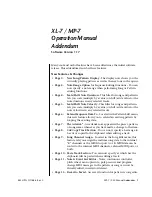
P/N 53063-30, Manual revision: B
A-5
Providing Reference Information
E. Gastric and Pancreatic
Fluid
Proteolytic enzyme may
cause red cell lysis.
Do not aspirate into system.
Resumption is an option after
copious irrigation with 0.9%
sodium chloride solution to
an alternate suction source.
F. Infection at Site of
Aspiration
Potential for bacteremia.
Avoid aspiration in the pres-
ence of purulent material.
G. Skin Lesions (Infectious)
Incising a lesion may intro-
duce organisms.
Cell salvage may be used if
incision is not through a
lesion.
H. Urine
Potential for bacteremia if uri-
nary tract infection present.
Avoid aspiration into system
in the presence of a urinary
tract infection.
I. Mucous Membrane
Procedures
Examples:
Oral, Nasal, Vaginal
Potential for bacteremia due
to normal resident bacteria.
Medical risks and benefits
should be discussed between
the surgeon and the medical
director of the surgical ser-
vices program.
Malignancy
A. Primary at Operative Site
Cell salvage is widely used in
surgical excision of malig-
nant tumors. The available
data would tend to indicate
that the procedure is safe and
does not increase the inci-
dence of metastatic disease.
However, since a control trial
has not been performed (and
it is questionable whether it
will ever be performed), the
decision to use cell salvage in
malignancies must be left to
the discretion of the surgeon.
Avoid cell salvaging at tumor
site.
Medical risks and benefits
should be discussed between
the surgeon and the medical
director of the surgical ser-
vices program.
Consider the use of a leukore-
duction filter.
B. Metastatic at Operative
Site
Potential for further spread of
disease.
Disease already systemic. Use
at discretion of surgeon.
Table A-1, Complications of and contraindications to perioperative blood recovery*
Substance
Effects
Recommended Action












































